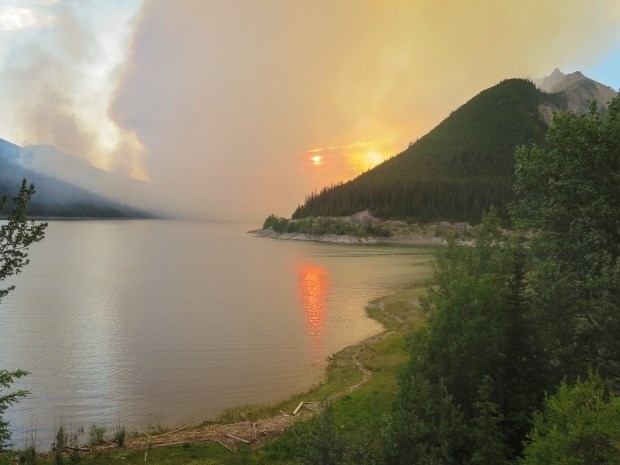Several fires are burning in the mountain national parks and a fire ban has been put in place because of dangerous wildfire conditions.
More than 400 wildfires are burning across Alberta, British Columbia and Saskatchewan, including a blaze in Jasper National Park, a fire in the remote Clearwater River Valley of Banff National Park and a smaller fire in Kootenay National Park.
Jane Park, fire and vegetation specialist for Banff National Park, said the fire ban in Banff, Jasper, Yoho, Kootenay, Mount Revelstoke and Glacier national parks is in place as a precautionary measure to reduce the likelihood of human-caused fires.
“In June, we normally get over 60 millimetres of rain in Banff, but we’ve gotten just over 30 mm. That’s half of what we would normally get. Especially in and around the Banff townsite, we haven’t had very much rain,” she said.
“That kind of trend of below normal precipitation and higher than normal temperatures has led to overall pretty serious fire conditions in Western Canada, including the parks.”
On Tuesday (July 14), a lightning-caused wildfire was spotted on the north slopes of Snarl Peak, approximately 80 kilometres north of the Banff townsite in a remote area of the Clearwater River Valley.
At press time, the size of the fire was approximately five hectares.
Parks Canada has closed off an area from the lower Clearwater River Valley from the Roaring Creek-Martin Lake junction on the west to the eastern park boundary near Indianhead Creek on the east
“Due to the remote location and terrain, Parks Canada fire crews are using indirect fire management techniques through ignition and aerial support to contain the fire,” said Christina Tricomi, a spokesperson for Banff National Park.
A wildfire in Jasper National Park that started on Thursday (July 9) is about 5,000 hectares in size, and forced several campgrounds and trails to be evacuated of visitors. About 1,000 people were evacuated from Maligne Valley over a two-day period.
Lightning is believed to have started the fire near Excelsior Creek in the Maligne Valley. Cooler weather and some rain helped fire crews and brought some relief over the weekend, preventing the fire from growing further.
On Saturday (July 11), lightning sparked two fires in the southern end of Kootenay National Park late that afternoon as a storm passed through.
A small fire adjacent to Highway 93 South near Settlers Road was immediately put out.
Another fire, about three to five hectares in size, is burning near Mount Daer, about four kilometres east of the Dolly Varden day use area on Highway 93 South.
Park said firefighters from provincial agencies used air tankers to dump water on the fire that night, and the following morning, fire crews from national parks went in to fight the fire on the ground.
“It’s under control and the goal is to extinguish it in the next few days,” she said.
“The fire is four kilometres from the highway and doesn’t pose a threat to the public or visitor facilities.”
More than 200 wildfires are burning in B.C., including one covering about 70 square kilometres in the Cariboo region, where a fishing lodge and several homes were destroyed over the weekend.
In Alberta, there are more than 100 wildfires burning and there are more than 120 burning in Saskatchewan.
Some comparisons are being made this year to the 2003 fire season, one of the most catastrophic in Western Canada’s recorded history. Forest firefighters faced conditions never seen before in Canada.
That year, the Tokumm-Verendrye creek fire in Kootenay National Park burned 18,000 hectares and came dangerously close to burning down historic Kootenay Park Lodge and closed Highway 93 South for several days.
Dubbed the “Holy Sh--” fire, there were concerns the wildfire would make it from Kootenay National Park to the Bow Valley and take a run at the Town of Banff less than 50 kilometres away.
Park said Banff went 42 straight days without rain in 2003.
“Definitely in terms of the amount of fire on the landscape, it looks like in Western Canada we are on track for the same number of hectares burned,” she said.
“July is usually the start of the fire season, and we’ve already been into it for a month. We will just have to wait and see what the weather brings. It can all change in an instant.”
Park said the federal agency is ready and well equipped for the fire season, noting they share resources with other national parks and can call on provincial agencies for help if needed as well.
“We want the public to be aware that we do have resources on standby here in the mountains and across the park system to keep everybody safe,” she said.
“There’s several aircraft and lots of fire crews that we can move around as priorities allow.”
The fire ban applies to all day-use areas, campgrounds, the Town of Banff, and the backcountry within Banff National Park. It’s also in place for Jasper, Yoho and Kootenay and Mount Revelstoke and Glacier national park.
Visitors and residents are only permitted to use gas or propane stoves during the fire ban. The use of charcoal briquettes is prohibited.
The fire ban will be lifted as conditions allow.




